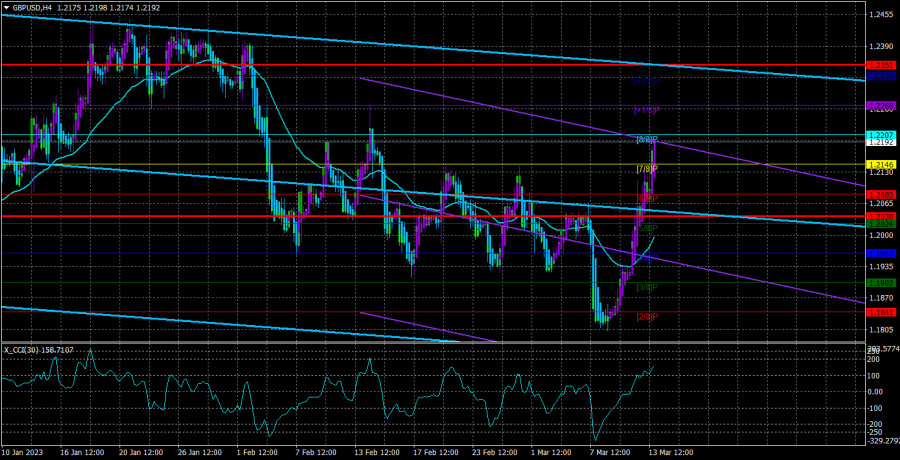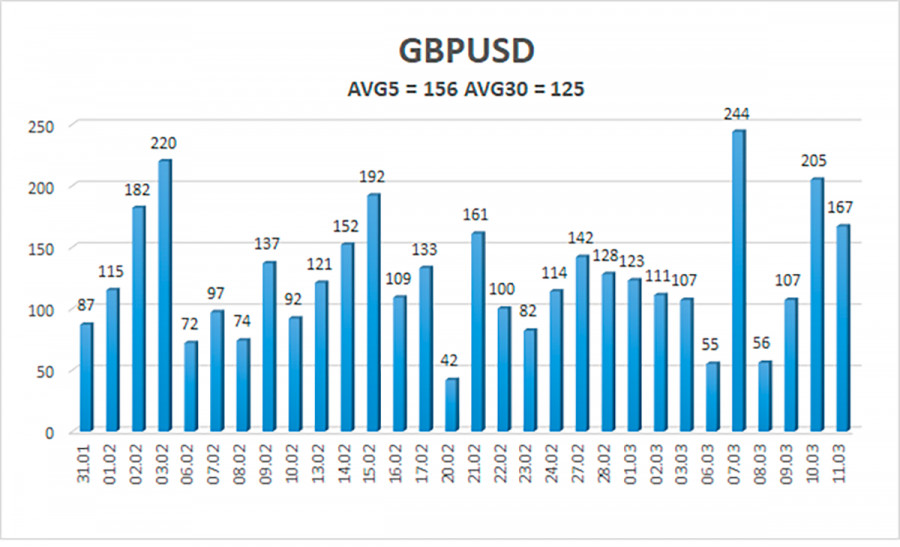

The GBP/USD currency pair steadily increased on Monday, finishing the day marginally above its recent local highs on the 4-hour TF. The reasons why the dollar fell substantially across the board in the market have already been discussed. It has more to do with the market's panic than it does with a rational response to the events that are occurring. For instance, Joe Biden stated in a speech yesterday that the US government will protect the banking system and prevent a "chain reaction." The Fed promptly took action to provide the banking sector with emergency lending. In general, even in the United States, when the economy crashes occasionally, it doesn't necessarily signal the start of a new financial crisis. As a result, we don't think the dollar will keep losing value for very long.
The 4-hour TF's technical image is currently excellent. Look at how frequently the pair has overcome the move in the past month and a half. This is all the information you require regarding the current market situation. If we use the 4-hour TF, it is neither "bullish" nor "bearish." Moreover, the pair has been flat on the 24-hour chart for a while. As a result, the pair grew for three whole days and can now pleasantly fall for the following three days. Trading concerning the moving average simply doesn't make sense right now. The same applies when attempting to identify the current trend using a 24-hour flat. Only the "swing" to be observed or traded on the smallest TF is left.
This week in the UK, there won't be much in the way of news or events. The same as last week. The most intriguing things will all be happening today. Reports on unemployment, wages, and unemployment benefit applications will be available. Although these statistics are "quite important," we do not anticipate a strong response. Be careful; the market is currently believing that other, far more significant events have occurred. Although the pair may engage in active trading at night, in the morning, and in the afternoon, this does not necessarily indicate that British statistics are causing the movements. The UK won't have any more significant occasions till the end of the week.
But everything will be as enjoyable as normal in the States. Joe Biden's emergency speech, as well as the Fed meeting "behind closed doors," took place yesterday. The first paragraph gave a brief overview of these events' outcomes. The release of the inflation data, which could be considered the "event of the week," will take place today in the United States. By the end of February, inflation is predicted to fall to 6–6.1% y/y, although, in our judgment, the decline might be less dramatic. There is no reason to speculate in any situation. The dollar can be supported by a milder inflationary decline than one that is strong enough to devalue it. But, we want to remind you that right now the market is agitated and viewing everything through the prism of the failure of two big banks and the effects these events will have on the economy. As a result, the response to inflation may be completely illogical.
On Wednesday, reports on retail sales and producer prices will be released. That is also "relatively important" data, with a possible reaction of up to 50 points. On Thursday, there will be a typical and uninteresting report on applications for unemployment benefits, and on Friday, the University of Michigan will release its secondary industrial production and consumer sentiment index. As you can see, there aren't many truly significant events, but when taken as a whole, they have the power to affect a few. At the same time, we are unsure of what information regarding Silicon Valley Bank's collapse will be released before the week's end. These findings can cause a more significant reaction than the inflation report. Yet, there is now no need to make a guess. Just keep in mind that the two can "fly" from side to side this week. As a result, surprisingly, the rate factor and the future Fed and ECB meetings have lost importance. This only complicates fundamental analysis and forecasting. The 24-hour TF, which contains the most significant benchmarks and the most powerful indications, deserves the most focus right now. Since intraday trends are currently much easier and quicker to track, you can also trade on the most junior TF. The pound typically "swings," and at the moment, this aspect is crucial.

Over the previous five trading days, the GBP/USD pair has experienced an average volatility of 156 points. This value is "high" for the dollar/pound exchange rate. So, we anticipate movement inside the channel on Tuesday, March 14 with movement being limited by levels of 1.2039 and 1.2351. A new round of movement to the south will be indicated by the Heiken Ashi indicator turning downward.
Nearest levels of support
S1 – 1.2146
S2 – 1.2085
S3 – 1.2024
Nearest levels of resistance
R1 – 1.2207
R2 – 1.2268
R3 – 1.2329
Trade Suggestions:
In the 4-hour timeframe, the GBP/USD pair once more consolidated above the moving average. Unless the Heiken Ashi indicator turns down, you can continue holding long positions with targets of 1.2268 and 1.2329. If the price is fixed below the moving average, short positions with targets of 1.1963 and 1.1902 may be taken into account.
Explanations for the illustrations:
Determine the present trend with the use of linear regression channels. The trend is now strong if they are both moving in the same direction.
Moving average line (settings 20.0, smoothed): This indicator identifies the current short-term trend and the trading direction.
Murray levels serve as the starting point for adjustments and movements.
Based on current volatility indicators, volatility levels (red lines) represent the expected price channel in which the pair will trade the following day.
A trend reversal in the opposite direction is imminent when the CCI indicator crosses into the overbought (above +250) or oversold (below -250) zones.